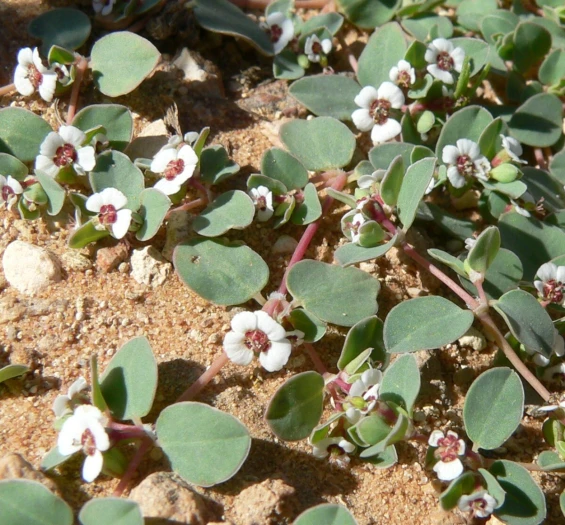Whitemargin Sandmat
(Euphorbia albomarginata)
Whitemargin Sandmat (Euphorbia albomarginata)
/
/

© Stan Shebs
CC BY-SA 4.0
Image By:
© Stan Shebs
Recorded By:
Copyright:
CC BY-SA 4.0
Copyright Notice:
Photo by: © Stan Shebs | License Type: CC BY-SA 4.0 | License URL: http://creativecommons.org/licenses/by-sa/4.0/ | Uploader: stanshebs | Publisher: iNaturalist |


















Estimated Native Range
Climate Requirements for Saga, Japan
| This Plant | Your Site | Plant Suitability for Your Location | ||
|---|---|---|---|---|
| • Precipitation | 2" - 65" | 71" | Aquatic | Aquatic |
| • High Temp. | 73°F - 115°F | 90°F | Your summer temperatures are normal for this plant. | Excellent |
| • Low Temp. | 9°F - 68°F | 35°F | Your winter temperatures are normal for this plant | Excellent |
This plant may not grow well at your location - your precipitation is too high.
Summary
Euphorbia albomarginata, commonly known as whitemargin sandmat or rattlesnake weed, is a perennial herb that is native to arid and semi-arid regions, including desert scrub, grasslands, and open woodlands in the southwestern United States and northern Mexico. It is particularly adapted to sandy or gravelly soils and thrives in full sun. The plant typically grows to a height of less than half an inch, forming dense mats up to a square foot in area. Its appearance is characterized by small, oblong, dusty green leaves and inconspicuous flowers surrounded by white bracts that give the impression of white margins, blooming from late spring to early fall.
Whitemargin sandmat is valued for its drought tolerance and ability to stabilize soil, making it suitable for xeriscaping and restoration projects. It requires minimal maintenance and is often used as a ground cover in arid garden settings. While it is not commonly used in culinary or medicinal applications due to its toxic sap, it has historical significance in folk medicine. Gardeners should handle this plant with care, as the milky sap can cause skin irritation and is toxic if ingested. It is best cultivated in well-drained soils and does not tolerate overwatering. There are no major disease problems associated with this plant, but it can spread quickly and may be considered invasive in some areas outside its native range.CC BY-SA 4.0
Whitemargin sandmat is valued for its drought tolerance and ability to stabilize soil, making it suitable for xeriscaping and restoration projects. It requires minimal maintenance and is often used as a ground cover in arid garden settings. While it is not commonly used in culinary or medicinal applications due to its toxic sap, it has historical significance in folk medicine. Gardeners should handle this plant with care, as the milky sap can cause skin irritation and is toxic if ingested. It is best cultivated in well-drained soils and does not tolerate overwatering. There are no major disease problems associated with this plant, but it can spread quickly and may be considered invasive in some areas outside its native range.CC BY-SA 4.0
Plant Description
- Plant Type: Herb
- Height: 1-2 feet
- Width: 1-2 feet
- Growth Rate: Slow
- Flower Color: White
- Flowering Season: Spring, Summer, Fall
- Leaf Retention: Deciduous
Growth Requirements
- Sun: Full Sun
- Water: Low
- Drainage: Fast, Medium
Common Uses
Deer Resistant, Drought Tolerant, Groundcover, Low Maintenance, Rock Garden
Natural Habitat
Native to arid and semi-arid regions, desert scrub, grasslands, and open woodlands in the southwestern United States and northern Mexico
Other Names
Common Names: Whitemargin Sandmat, White-Margined Spurge, White-Margin Sandwort
Scientific Names: Euphorbia albomarginata, Chamaesyce albomarginata, Chamaesyce hartwegiana, Euphorbia hartwegiana, Euphorbia stipulacea, Euphorbia stipulacea
GBIF Accepted Name: Euphorbia albomarginata